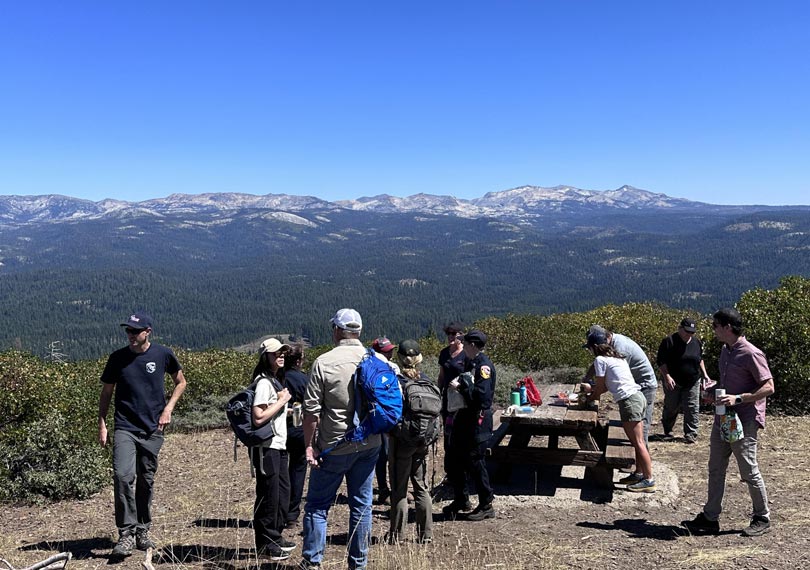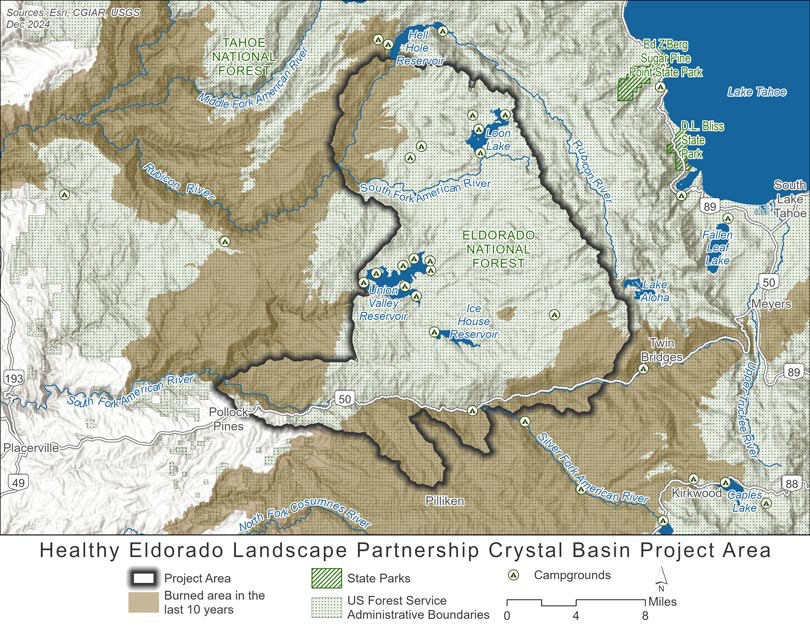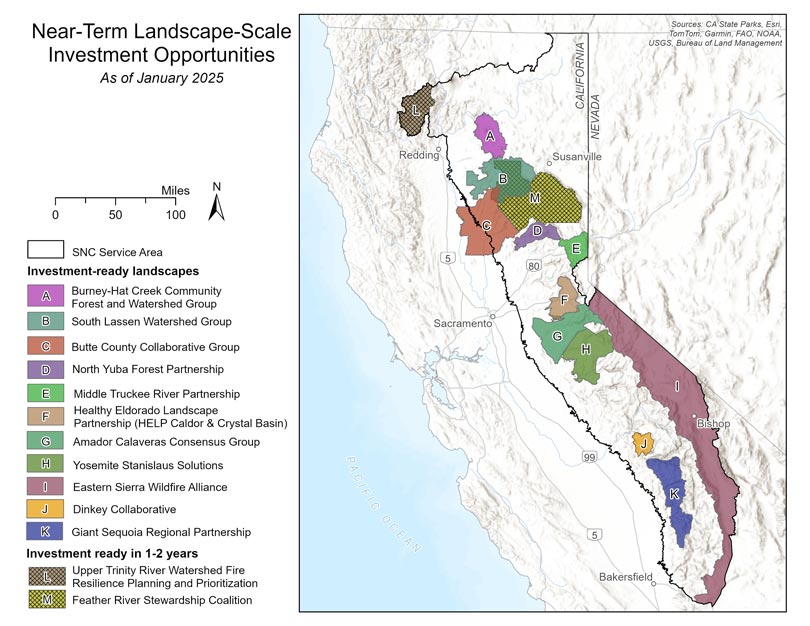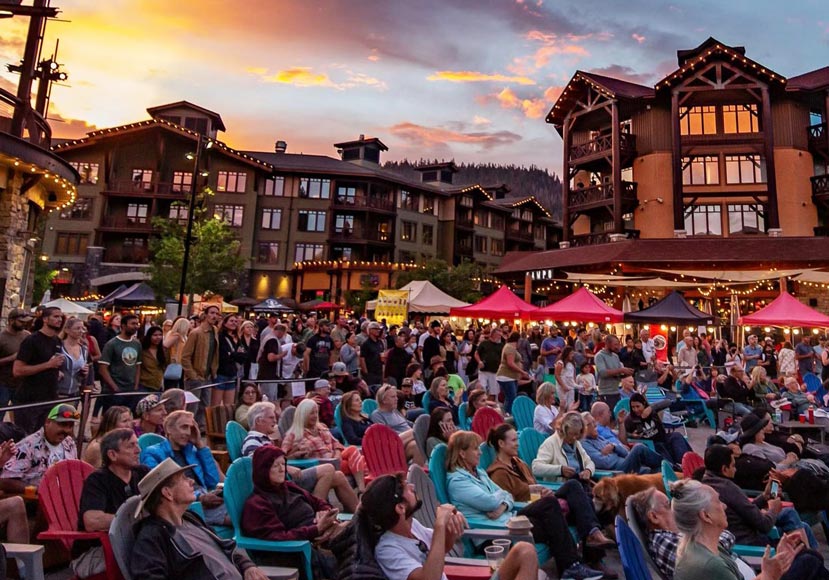
Last year, the Sierra Nevada Conservancy (SNC) made the inaugural award in a Landscape Grant Pilot Program to the Healthy Eldorado Landscape Partnership’s (HELP) Crystal Basin Project. The pilot grant seeks to align state and federal funding sources into one, larger grant and create efficiencies for funders and grantees alike. The hope is grants of this nature will help increase the pace and scale of forest restoration to meet California’s wildfire crisis at the scale of modern megafires that burn across larger landscapes.
Restoring a large landscape requires more than just a lot of funding, it also takes people with the skills, expertise, and knowledge to turn that money into meaningful work on the ground. To select our first landscape grant recipient SNC looked across our service area for local partners with the capacity to do just that, and the results were extremely encouraging—while there could be only one inaugural award, there were at least 10 Sierra-Cascade landscapes ready to make good use of landscape-scale funding.
Healthy Eldorado Landscape Partnership getting to work with $10 million in Crystal Basin
After a rigorous evaluation process, the SNC, CAL FIRE, and the US Forest Service awarded the inaugural pilot landscape grant to HELP’s Crystal Basin Project in June 2023. Although HELP is a newer collaborative, it brings together proven implementation partners to do urgent work in the Crystal Basin, an area that is home to immense carbon stores and treasured recreation sites, making its restoration a top priority for both state and federal funding partners.

Together, CAL FIRE, the SNC, and the US Forest Service committed $10 million, meeting nearly half of the estimated $23 million needed to complete shovel-ready, wildfire-resilience projects in the Crystal Basin over the next 5-10 years. Those funds support a strategic portfolio of fuel reduction and recreation infrastructure improvements in the Crystal Basin, a scenic island of green forest and mountain lakes in the Eldorado National Forest that is surrounded by large, high-severity burn areas created by the 2014 King Fire and 2021 Caldor Fire.
As a result of this catalyst funding, HELP is already seeing early, unanticipated successes.
While the acceleration of forest-resilience work in a critical landscape was an expected outcome of the Landscape Grant Pilot Program, a good, but unexpected outcome was the identification of at least nine other Sierra-Cascade landscapes that are also ready to get to work at the landscape-scale.
At least ten Sierra-Cascade landscapes ready for landscape-scale resilience work
Faced with escalating climate and wildfire crises, communities across the Sierra-Cascade are uniting behind shared landscape-specific visions of resilience. In many places, these visions are driving the formation of broad-based, land-management collaboratives that are adopting clear strategic approaches, supported by a portfolio of shovel-ready and planning projects, to restore resilience across a large landscape. At least 10 are now ready to rapidly turn large amounts of funding into meaningful change on the ground.

Building a pipeline of investment-ready landscapes
The SNC believes in meeting its Regional partners where they are. This means that we support forest- and wildfire-resilience efforts in a variety of ways that are tailored to meet the diversity of needs throughout our large service area. We invest in every phase of the life of forest and wildfire resilience projects, while providing organization-building resources and technical assistance to partners doing work on the ground. Our end goal is to help partners build a pipeline of ready projects, and ultimately, a pipeline of investment-ready landscapes.
An infusion of funding from a series of Department of Conservation block grants to administer the Regional Forest and Fire Capacity Program in the Sierra-Cascade has increased capacity-building grants to support collaboration and planning at a larger scale, with dramatic results. Over the near-term, this will result in many more organizations that will be ready to implement much-needed restoration work across larger landscapes once funding has been secured.
On the eastside of the Sierra Nevada, community leaders have planned, permitted, partially funded, and begun work, on a landscape scale “donut” of resilience surrounding Mammoth Lakes. Support from the SNC began with a neighborhood fuel-reduction project, and expanded to support collaborative planning and coordination needs as local ambitions, and capabilities, grew.
The SNC’s role in supporting landscape-scale work in Sierra County also began with an implementation grant. That project, spearheaded by Sierra County, helped to bring together the North Yuba Forest Partnership, which, utilizing another SNC grant, created a restoration plan for the entire North Yuba Watershed. With a plan in place, the North Yuba Forest Partnership secured $160 million in federal funding that is poised to dramatically improve wildfire and forest resilience.
Similarly, the SNC began working with the Amador Calaveras Consensus Group and the Upper Mokelumne River Watershed Authority (UMWRA) shortly after the 2013 Rim Fire inspired a newfound focus on forest health. This support has taken many forms as it has steadily planned, built internal capacity, and secured funding that has UMRWA poised to restore roughly 250,000 acres of the Mokelumne River watershed.

In addition to planning, implementation, and capacity-building grants, SNC staff provide technical, networking, and grant-writing assistance to partners throughout our service area, including forest-health collaboratives. This combination of funding and technical assistance is how the SNC helps to forge the know-how and working relationships needed to tackle resilience at a landscape level.
